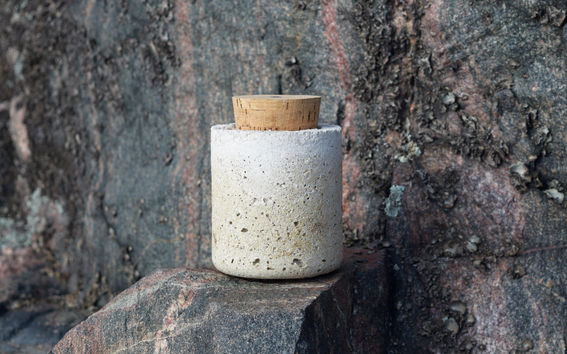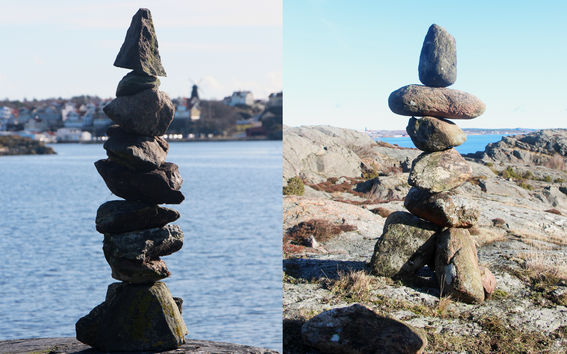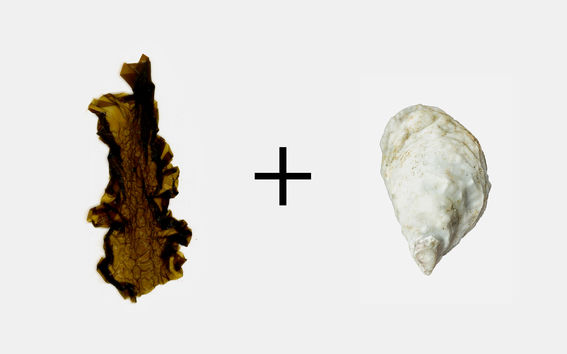Ritual & Sustainability: A Proof of Concept for a Shell-Algae Based Burial Urn, George Seppala

This is a proof of concept for a biodegradable sea-burial urn made of algae and shells that facilitates a symbolic engagement between a deceased person and the ocean, a person who may have lived a life connected with the ocean, while also addressing the issues of a climate crisis concerning the ocean.
The cremation urn for sea burials is made of a mixture of alginate and oyster shells shaped in a mould. The oyster shells act as an aggregate and source of calcium that hardens when mixed with the alginate to provide structural integrity. The resulting composite can dissolve when left in the ocean as it is vulnerable to the effects of erosion and acidification. On a very small scale, the calcium from the urn very slightly neutralises some of the acids that now plague the ocean. This option of a vessel for the transition into the afterlife may be appropriate for those who want to leave a legacy on the physical planet that would be environmentally positive or neutral for eternity while at the same time acknowledging a connection between their life and the sea.

The Ocean & Us
During my time at Kristineberg, my interest was not only drawn by the science being done, but also by the relationships of humans with the ocean and how the relationships manifest. People are inspired by the ocean, studying it, making art about it, finding solace in it, being nourished by it and building lives and livelihoods around it. Humans are deeply connected to the ocean, in both logical and spiritual ways. We still rely on the ocean for a great deal of our oxygen and food, and as a species, the ocean is our place of origin, humans having evolved out of it 540 million years ago. When in its presence, we revere and are humbled by the sea. The power of nature is felt when one is around this natural phenomena; this feeling is an increasingly unfamiliar one in our modern age, which unfamiliarity or disconnectedness perhaps contributes to our disregard for these ecological entities. A example of this is the ongoing problem of ocean acidification that plagues our ocean. It is primarily the result of human’s production of too much carbon dioxide as a result of our modern. The effects are the extinction of plants and animals in the sea, depleting a source of oxygen and food for humans and other species.
Burials at sea have been demonstrated by many cultures. There are parallels to other ceremonies where people embrace nature in the funeral process. Funerals in bodies of water are practiced either with cremated ashes or whole bodies. For example, Western mariners, including navies, often perform sea burials. Hindus perform Antyesti (the last Sacrifice) with their dead by floating partially cremated bodies into the Ganges river and Buddhists in Tibet perform sky burials where the deceased is left to be eaten by vultures, the body bit by bit carried into the sky by the birds, in each case providing sustenance for the ecosystem. These burials in contrast to embalming and inert coffins and urns, are much more responsible and generous towards the environment. More recently in the west where less eco friendly burials have been convention, people are considering alternatives These alternative eco friendly burials aspire to have no environmental impact, and in fact benefit the environment through the process. New “eco burials”, like tree pod burials and mushroom burials encourage decomposition as part of a energy source in a nutrient cycle for other organisms to thrive.

Rituals & Sustainability
Burials at sea have been demonstrated by many cultures. There are parallels to other ceremonies where people embrace nature in the funeral process. Funerals in bodies of water are practiced either with cremated ashes or whole bodies. For example, Western mariners, including navies, often perform sea burials. Hindus perform Antyesti (the last Sacrifice) with their dead by floating partially cremated bodies into the Ganges river and Buddhists in Tibet perform sky burials where the deceased is left to be eaten by vultures, the body bit by bit carried into the sky by the birds, in each case providing sustenance for the ecosystem. These burials in contrast to embalming and inert coffins and urns are much more responsible and generous towards the environment. More recently in the west where less eco-friendly burials have been the convention, people are considering alternatives. These alternative eco-friendly burials aspire to have no environmental impact, and in fact, benefit the environment through the process. New “eco burials”, like tree pod burials and mushroom burials encourage decomposition as part of an energy source in a nutrient cycle for other organisms to thrive.
Like anything, spiritual practice does not necessarily justify unsustainable ornamental objects with unquantifiable, subjective social and ecological benefits. With the right approach, there is potential for designed objects to be net positive socially and ecologically. This urn, for example, is inherently sustainable, made of elements of the sea, degradable, while acting as a calcium deposit that neutralises some of the acids in the ocean, a symbolic and functional demonstration of unity between humans and the sea and the larger natural environment. The practice of disposing of a loved one’s cremated ashes in an urn in a location where the deceased may have felt an affinity towards the environment could strengthen relations between humans and nature.
Modern design is predicated on selling things with “apparent” function, utilitarian designs with evidence-based benefits attributed to scientific and technological advancement-design rooted in a self-destructive, unsustainable ethos occupied with rapid technological growth and consumption. This is not to say science and technology do not benefit the fight for sustainability, but the spiritual dimension is underrepresented in this fight by Westerners and possibly others. The less popular spiritual approach has the power to re- orient people to find connections with nature and find direction in life that would reduce the obsession with technological growth and consumerism, therefore reducing the demand for resources, benefiting the environment.

Processes & Next Steps
*Due to the outbreak of coronavirus and the closure of the school, some processes and materials have been substituted.
For the making of the urn, oyster shells were baked and crushed then washed a number of times with hot water to remove the salt. The shells by weight were then mixed with 40% alginate. the mixture was shaped in a coffee press with an additional tea strainer to create the cavity, what is left is an open- ended vessel with 1.5cm thick walls. Once under pressure and in the final shape, I poured a mixture of calcium chloride. The shape was partially dried under pressure for 6 hours then removed from the press to completely dry.
If I had access to the school I would have tried to derive the alginate from the algae myself using either the calcium alginate process or the alginic acid process both of which require lab equipment and chemicals to undertake. I would have tried to make calcium chloride one of two ways. The first would have been the same way shells are processed for cement, to cook the shells (CaCO3) in a kiln at 1200 degrees, which produces CaO and CO2 (powder). This powder could then be mixed with water and hydrochloric acid (this reaction generates a lot of heat and it can be dangerous to mix them if not added very little at a time) to create calcium chloride(CaCl2). The second would be to directly dissolve the shells in hydrochloric acid ( however I think this would require lots of time and acid).
Next some form of aggregate, for example, ground shells, sand or algae fibre would be added to bulk up the mix and add rigidity. The process of moulding would be the same. The shapes made need to account for some shrinkage, and the moulds used must allow for some of the liquid to release wither in the pressing or in evaporation, so the mould must be permeable or hydrophobic, yet still, restrict the aggregate.

Sources
Walker, S. (2014) Designing Sustainability: Making radical changes in a material world, Routledge, Abingdon, OX, pps 54-71
Walker, S. (2003) Light Touch – The Design of Ephemeral Objects for Sustainability, The Journal of Sustainable Product Design 3:187–198
Doughty, C. (2017). From here to eternity: Travelling the world to find the good death. Hachette UK.
Bodies Through Time: A Historian Traces Our Evolving Relationship With The Dead. (2015, December 15). Retrieved from https://www.npr.org/sections/health-shots/2015/12/15/459757970/bodies-through-time-a- historian-traces-our-evolving-relationship-with-the-dead






